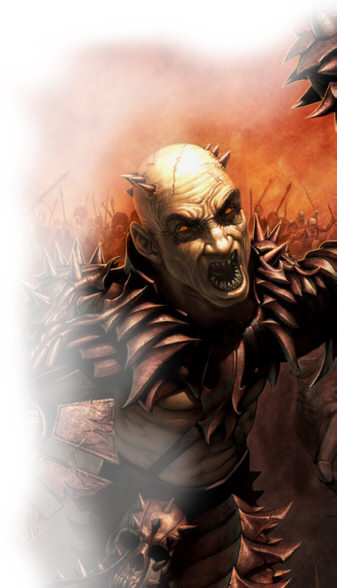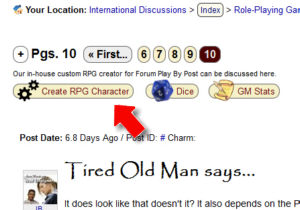 Close Topic Options
Close Topic OptionsDungeons & Dragons Start Guide
Dungeons Dragons Start Guide - Board, Card, RPG Reviews - Posted: 10th Mar, 2016 - 2:34am
31st July 2025's Text Adventure:
Choose Your Medieval Fantasy Character:









Dungeons & Dragons Start Guide
The current Role-playing Game is:

Dungeons & Dragons Start Guide
Update November 2018: Please note that we no longer service Dungeons & Dragons / Pathfinder games here as our focus will be on our in house custom systems like ROK II that concentrates on role-play rather a need to know rules, have special dice rolls, or a Dungeon Master that is often inconsistent, etc. While Dungeons & Dragons is quite popular it is often run with certain expectations that are not all inclusive thus limiting the kind of Player participation that should be free and open.
To start participating in Play by Post Dungeons & Dragons in the Member Wars Board you need to follow the below steps:
1. Join the Community
Membership is free! Ensure you read the Registration rules as our Community is very strict in the way it is moderated as we cater for a more mature minded participant. Potential Players who take it lightly often find their account deleted. .
2. Validate your Email
There is a link in your Registration Email (The one you Registered with) that must be clicked. If you did not get the Email it may have gone to your Spam / Junk folder. Optional: Please check there and use this tip to make sure our Emails go to your Inbox next time: .
3. Post your Introduction
A couple of lines about yourself (No confidential or contact info please) and your purpose for joining. Post Your Introduction. Once posted it needs to approved first before being made public. Sorry for this extra step but it protects the Community from spammers and malicious advertizes.
4. Decide which Dungeon Master's Game you will join
Each Dungeon Master has their own rules and requirements for Players. See Member Wars and look for the Threads that talk about "Character Creation".
You can select specific Dungeons & Dragons Versions using one of these buttons:
also available:
If the Thread is Closed / Locked it means that Dungeon Master is not accepting any more Characters. If it is open then click on the link so the Thread / Topic can open and use the "Create Role-playing Game Character" Button at the top of the page (See attachment below). You will then be able to establish your Character and the necessary fields to hold player information. Let the GM know about your Character in the same Thread.
Optional For a comparison of other Medieval Based Role-playing Games see: Medieval Options
More Dungeons & Dragons Based Role-playing Game offerings see: Dungeons & Dragons Options
5. Don't become lost or start talking to yourself
If you do not see an available Role-playing Game then you have many other options as Dungeons & Dragons is NOT the only Role-playing Game we run. You can also start your own! See: How To Find The Role-playing Game That Fits Me?

6. Create your Dungeons & Dragons Character
UPDATE: The Text Role-playing Game Creator can help you create a Dungeons & Dragons 2.0, 3.5 and 4.0 Characters.
If your chosen Dungeon Master is using Dungeons & Dragons 3.5 rules then you can optionally use the Dungeons & Dragons Character 3.5 Generator to create your character. For other versions: Advance Dungeons & Dragons, Dungeons & Dragons 4, and Dungeons & Dragons 5 you can create your own and then show the GM your Character. If not, you will need to roll dice using the rule book or another generator that is good for you. Dungeon Masters usually do help Players create their Characters, please follow their instructions.
7. Post your Character for Approval
Look for the "Characters" Thread of the Dungeon Master you selected and place your character there. The Dungeon Master will notify you if your character is approved and what to do next.
Still Have Questions About Dungeons & Dragons? Ask within this Thread or Member Wars Support.
An older guide that may also be helpful: Dungeons & Dragons Play By Post: How It Works
Note: Disclaimer: We are NOT an official site for Dungeons & Dragons or Wizards. Members are merely allowed to create whatever games they like and Dungeons & Dragons is one of the more popular choices. The Dungeons & Dragons manuals and generator have all been made available here through permission.

Dungeons & Dragons Start Guide (Hover)
Guide Start Dragons and Dungeons
Dungeons & Dragons More Options
Use any of these to help you make the best use of Character building and Role-Play Gaming.
Dungeons & Dragons 3.5 Character Generator
Dungeons & Dragons Manuals: Feats, Skills, Spells, Characters, & Monsters
Test the Create Role-playing Game Character
Dungeons & Dragons Start Guide Reviews RPG & Card Board
D&D combat in one page (Of really small type)
Initiative
Every round, each person acts once, from highest initiative to lowest. Your initiative is determined by rolling 1d20 + your Dexterity bonus, and stays the same until the end of the combat.If some participants are taken by surprise, the other ones get a free round before the surprised ones can act.
Before the very first time you act in a combat, you are "flat-footed"; you don't get a Dexterity bonus to your armor class and can't make Attacks of Opportunity (See below).
Taking actions
There's lots of confusing stuff in the rules about standard actions, full-round actions, move actions, free actions, etc. Here's what I think is a simpler way to think about it:- You have 5 action points in a round to spend however you like.
- Full-round actions cost 5 points.
- Standard actions cost 3 points.
- Move actions cost 2 points.
- Free actions cost 0 points.
- If you haven't otherwise moved, you can always move five feet for 0 points.
Attacks of Opportunity (AoO)
Some things that you do (Typically, actions that distract you from defending yourself) provoke an Attack of Opportunity (AoO), which means that nearby opponents get a free attack (Although a combatant can only take one AoO per round, even if multiple opponents provoke one). So try to avoid that. Withdraw and Move Five Feet are particularly helpful in avoiding attacks of opportunity while remaining mobile.Actions
I've left out actions that are obscure or high-level. Actions that provoke 'Attacks of Opportunity' are marked with a star.- Withdraw (5). Move up to double your speed without provoking an AoO due to moving out of your current spot.
- Run* (5). Move up to four times your speed, but lose your Dexterity bonus to your armor class.
- Melee attack (3). Take one swing at an enemy. If you like, you can fight defensively by taking a -4 penalty to hit in return for a +2 armor class bonus.
- Ranged attack* (3). -4 to hit if your target is engaged in melee with an ally of yours.
- Unarmed attack* (3). Only your opponent gets an AoO.
- Full attack (5). If you have multiple attacks, you need to use this action in order to use all of them.
- Cast Spell* (3). If you take damage from the AoO, you have to make a Concentration check to finish the spell. You can try to avoid provoking an AoO by making a Concentration check (DC 15 + spell level), but if that fails, you lose the spell.
- Move* (2) up to your speed. Causes an AoO if you move out of a threatened area.
- Crawl* (2) five feet if you're unfortunate enough to be prone.
- Draw a weapon (2)
- Manipulate an item (2), like open a door or pick something up.
- Stand up (2)
- Drop an item (0)
- Drop prone (0)
- Talk (0)
- Move five feet (0) but only if you are not otherwise moving this round.
- Delay action (5). Wait until later this round to act, but your initiative stays at that reduced value.
- Ready action (3). Prepare a specific action to respond to another specfic future action (E.g., "as soon as something comes through the door I shoot it").
Resolving a normal attack
Roll a d20 + your Base Attack Bonus + your Strength modifier (Or Dexterity if it's a missile weapon). If you beat your target's armor class (AC), you do damage equal to your weapon + your Strength modifier (Only if it's not a missile weapon).If you roll a 1, you automatically miss. If you roll a 20, you automatically hit. If you roll in your weapon's threat range (Typically just 20 but sometimes more), you may have a critical hit; roll again, and if that's a hit, you do some multiple of your usual damage.
For damage, roll the dice associated with your weapon and add your strength bonus (One and a half times the strength bonus if it's a two-handed weapon, or half of the strength bonus if the weapon is in your off hand). Damage can't go below 1.
Injury and death
A combatant reduced to 0 hit points is disabled (3 action points per turn). At -1 HP, you're dying. Every round, you have a 10% of becoming stable; otherwise you lose another hit point. When you reach -10, you die. You can stabilize someone by successfully making a DC 15 Heal check.
Combat modifiers
If the defender is behind physical cover, he gets +4 to his armor class.If he has concealment (E.g., in darkness, fog, or tall grass), then any successful hit on him has a 20% chance of missing anyway.
If you and an ally are on opposite sides of a defender, he is flanked and you both get +2 to hit.
Special attacks
You can make other kinds of attacks than just swinging or shooting at someone, if you're feeling creative:- Aid another (3). Instead of attacking an enemy, roll against AC 10. If successful, your friend gets +2 to hit or +2 AC against that enemy until your next turn.
- Bull rush* (3). Make an opposed Strength check to push the defender back five feet (Useful if you're on the edge of a ravine!).
- Charge (5). Move at least 10 feet and at most double your speed, then attack with +2 to hit and -2 to your AC.
- Disarm* (3).
- Your target gets an AoO. If he does damage, you fail.
- Make an opposed attack roll. Two-handed weapons get +4, light weapons get -4. Larger combatants get +4 per size difference.
- If you won, the defender is disarmed. If you failed, the defender gets to make a check as in 2. To disarm you.
- Feint (3). Make a Bluff check against the opponent's Sense Motive + BAB. If you win, on your next attack against him he doesn't get a Dexterity bonus.
- Grapple* (3).
- Your target gets an AoO. If he does damage, you fail.
- Make a melee touch attack to grab.
- Make an opposed grapple check (BAB + Strength bonus + 4 per size difference) to hold and do unarmed strike damage.
- Overrun* (3).
- Defender can simply step aside and let you move through if he wants.
- If he blocks, make a Strength vs Dexterity/Strength check, plus 4 per size difference.
- If you win, he is knocked prone and you can keep moving. If you lose, he makes the same check as in 2. To knock you prone.
- Sunder* (3): try to attack his weapon or shield. Make an opposed attack roll as per Disarm to do damage to it.
- Trip* (3).
- Your target gets an AoO unless you are tripping it with a special trip-enabled weapon.
- Make an unarmed touch attack (Or a melee attack if you are using a weapon).
- If that succeeds, make an opposed check as per Overrun.
- If you win, he is knocked prone. If you lose, he makes the same check as in 3. To knock you prone.
- Two-weapon attack (3). If you want to attack with two weapons, the first one is -6 to hit and the second is -10 (-4/-8 if the off-hand weapon is light, -4/-4 if you have the Two-Weapon Fighting feat, -2/-2 if both).
 TOPIC: Dungeons & Dragons Start Guide
TOPIC: Dungeons & Dragons Start Guide How to play Dungeons & Dragons Play By Post in this Community
How to play Dungeons & Dragons Play By Post in this Community